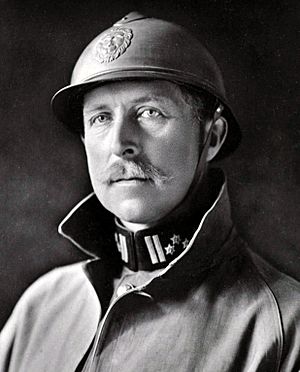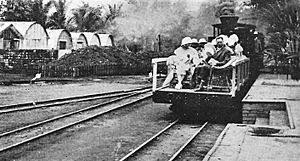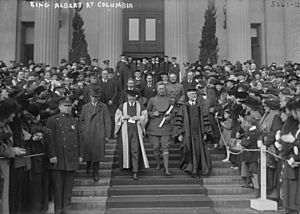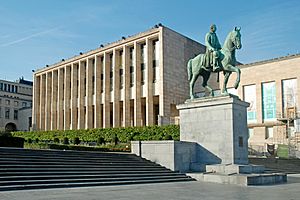Albert I of Belgium facts for kids
Quick facts for kids Albert I |
|||||
|---|---|---|---|---|---|

Albert I, pictured with his characteristic Adrian helmet, c.1919
|
|||||
| King of the Belgians | |||||
| Reign | 23 December 1909 – 17 February 1934 | ||||
| Predecessor | Leopold II | ||||
| Successor | Leopold III | ||||
| Prime Ministers |
See list
Frans Schollaert
Charles de Broqueville Gérard Cooreman Léon Delacroix Henri Carton de Wiart Georges Theunis Aloys Van de Vyvere Prosper Poullet Henri Jaspar Jules Renkin Charles de Broqueville (2nd time) |
||||
| Born | 8 April 1875 Brussels, Belgium |
||||
| Died | 17 February 1934 (aged 58) Marche-les-Dames, Namur, Belgium |
||||
| Burial | Church of Our Lady of Laeken | ||||
| Spouse |
Elisabeth of Bavaria
(m. 1900) |
||||
| Issue | Leopold III of Belgium Prince Charles, Count of Flanders Marie-José, Queen of Italy |
||||
|
|||||
| House | Saxe-Coburg and Gotha (until 1920) Belgium (from 1920) |
||||
| Father | Prince Philippe, Count of Flanders | ||||
| Mother | Princess Marie of Hohenzollern-Sigmaringen | ||||
| Religion | Roman Catholicism | ||||
Albert I (born 8 April 1875 – died 17 February 1934) was the King of the Belgians from 1909 until his death in 1934.
He was born in Brussels, Belgium. Albert was the second son of Prince Philippe, Count of Flanders, and Princess Marie of Hohenzollern-Sigmaringen. In 1909, he became king after his uncle, Leopold II, passed away. Albert married Elisabeth of Bavaria, and they had three children.
Albert's time as king was very important for Belgium. It included World War I (1914–1918), when most of Belgium was taken over by German forces. Other big events were the Treaty of Versailles in 1919, Belgium's rule over the Belgian Congo, and the start of the Great Depression (1929–1934).
King Albert died in a climbing accident in 1934, when he was 58 years old. His son, Leopold III, became the next king. People in Belgium often call him the Knight King or Soldier King because of his brave actions during World War I.
Contents
Early Life of King Albert I

Albert Léopold Clément Marie Meinrad was born on 8 April 1875 in Brussels. He was the fifth child and second son of Prince Philippe, Count of Flanders. His mother was Princess Marie of Hohenzollern-Sigmaringen.
His grandfather was Leopold I, the first King of the Belgians. Albert's uncle, King Leopold II, was the reigning king. At first, Albert was third in line to the throne. But his older brother, who was being prepared to be king, died young. This meant that Albert, at age 16, suddenly became second in line after his father.
Albert was a quiet and thoughtful person. He worked hard to get ready for his future role as king. He cared a lot about the lives of working-class people in Belgium. He even traveled secretly to poor areas to see how people lived.
Before he became king in 1909, Albert visited the Belgian Congo. Belgium had taken control of it in 1908. He saw that conditions there were not good. When he returned, he suggested changes to help the local people and improve the colony's technology.
Marriage and Family
Albert married Elisabeth Gabrielle Valérie Marie in Munich on 2 October 1900. She was a princess from Bavaria. They had met at a family funeral. Elisabeth was born on 25 July 1876 and passed away on 23 November 1965.
Their letters show they were very much in love. They supported each other in their important roles as king and queen. They both cared deeply about their country and family. They were also very interested in new ideas and progress. They invited many famous scientists, artists, and thinkers to their home. This made their court a place for cultural discussions.
Their Children
Albert and Elisabeth had three children:
- Léopold Philippe Charles Albert Meinrad Hubert Marie Michel: He became the fourth King of the Belgians, known as Leopold III. He was born on 3 November 1901 and died on 25 September 1983.
- Charles Théodore Henri Antoine Meinrad: He was the Count of Flanders and Prince Regent of Belgium. He was born on 10 October 1903 and died on 1 June 1983.
- Marie-José Charlotte Sophie Amélie Henriette Gabrielle: She became the last Queen of Italy. She was born on 4 August 1906 and died on 27 January 2001. She married Prince Umberto of Piemonte in 1930. He later became King Umberto II of Italy.
Becoming King
Albert became King of Belgium in December 1909 after his uncle, Leopold II, died. Albert's own father had passed away in 1905.
Before Albert, Belgian kings only took their oath in French. Albert was the first to take it in Dutch as well. He and Queen Elisabeth were well-liked because they lived a simple life. Their family life was happy, which was different from King Leopold II. Early in his reign, Albert made many changes to improve how the Belgian Congo was managed.
World War I and the Soldier King
When World War I began, Germany asked to move its troops through Belgium to attack France. King Albert refused. This led to Germany invading Belgium in 1914. Because of an old agreement from 1839, this invasion brought Britain into the war.
King Albert took personal command of the Belgian Army, as the Belgian constitution allowed. He held off the Germans long enough for Britain and France to get ready for the Battle of the Marne. He led his army through tough battles, like the Siege of Antwerp and the Battle of the Yser. The Belgian Army was pushed back to a small area near the North Sea.
There, the Belgians, with other Allied armies, fought from trenches for four years. King Albert stayed with his troops and shared their dangers. Queen Elisabeth worked as a nurse at the front lines. It was even rumored that German soldiers respected him so much they wouldn't shoot at him. King Albert also let his 12-year-old son, Prince Leopold, join the army as a private.
The war caused great suffering in Belgium, which was under harsh German rule. King Albert was worried about the damage the war was doing. He tried to find a way for Germany and the Allies to make peace without a clear winner or loser. He believed this would protect Belgium and bring stability to Europe. However, his efforts were not successful.
At the end of the war, King Albert led the final attack that freed Belgium. He, Queen Elisabeth, and their children returned to Brussels and were welcomed as heroes. The King Albert I Memorial in Nieuwpoort honors him and the Belgian troops from the war.
After the War
When King Albert returned to Brussels, he spoke about the changes he wanted for Belgium. These included a stronger military, universal suffrage (meaning everyone could vote), and a Flemish University in Ghent.
Visit to the United States

From September to November 1919, King Albert, Queen Elisabeth, and their son Prince Leopold visited the United States. They visited a Native American village called Isleta Pueblo, New Mexico. King Albert gave an award to a priest there, Anton Docher. The visit was seen as a big success for Belgium.
Voting Rights for Men
Before the war, men's votes depended on their wealth or education. After a big strike in 1913, there was a promise to change this to "one man, one vote." The war delayed this change.
In 1918, King Albert helped create a "Government of National Union." This government included members from Belgium's three main political parties. He helped them agree to give all men the right to vote, with each man having one vote.
Paris Peace Conference

In April 1919, the Belgian government sent King Albert to the Paris Peace Conference. There, he met with leaders from France, Britain, and the United States. He had four main goals:
- To rebuild Belgium's economy using money from Germany.
- To make Belgium safer by creating a new buffer state.
- To update an old treaty from 1839.
- To improve relations between Belgium and Luxembourg.
He advised against making the peace treaty too harsh on Germany. He thought this could lead to more problems later. He also believed that breaking up empires like the Habsburg Empire could cause instability. While Belgium was seen as the main victim of the war, the King's advice did not have a big impact in Paris.
Later Years and Legacy
Albert spent much of his later reign helping Belgium recover and rebuild after the war.
In 1920, he changed the royal family's name from "Saxe-Coburg-Gotha" to "House of Belgium". This was because of strong anti-German feelings after the war. The British royal family had done something similar.
King Albert was also very interested in protecting nature. In 1925, he helped create Africa's first national park, now called Virunga National Park, in what is now the Democratic Republic of Congo. He was also the first European king to visit the United States while still ruling.
Death of King Albert I
King Albert I loved mountain climbing. On 17 February 1934, he died in a climbing accident. This happened while he was climbing alone at Marche-les-Dames, in the Ardennes region of Belgium. His death shocked the world, and many people mourned him.
Because he was an expert climber, some people wondered if it was truly an accident. They suggested he might have been murdered or that his body was moved. Authorities investigated these ideas, but doubts have remained. These doubts have even inspired books and documentaries.
Like the kings before him, Albert I is buried in the Royal Crypt at the Church of Our Lady of Laeken in Brussels.
In 1993, a climbing friend of the King, Walter Amstutz, started the King Albert I Memorial Foundation. This group honors important people in the climbing world. In 2008, a special 12.5 euro coin was made to celebrate 175 years of the Belgian Dynasty and 100 years since Albert became king. The coin shows a picture of the King.
See Also
 In Spanish: Alberto I de Bélgica para niños
In Spanish: Alberto I de Bélgica para niños
- Kings of Belgium family tree
- Crown Council of Belgium
- Royal Trust





